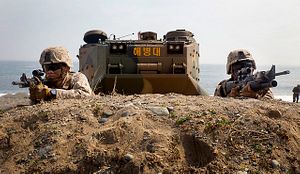At the press conference that followed the historic summit between the United States and North Korea in Singapore on June 12, when asked about providing security guarantees to North Korea and reducing the number of U.S. forces stationed in South Korea, U.S. President Donald J. Trump responded that he wanted to return the “32,000” U.S. forces stationed in South Korea to the United States someday, but not now. Subsequently, Trump made the explosive statement that he would cancel war games between the United States and South Korea; that is, their combined military drills.
A spokesman from the U.S. Department of Defense explained that Defense Secretary James Mattis had held prior discussions with the president about canceling joint military drills. However, what they agreed was not to cancel the drills but to avoid actively promoting them while in dialogue with North Korea.
Mattis visited Japan and South Korea at the end of June and stressed that the United States would keep its forces stationed in South Korea even after the combined military drills were canceled. Yet it does now appear inevitable that there will be a review of U.S. Forces Korea (USKF)
Indeed, private and public think tanks in Washington D.C. have already begun to think about what impact a review of the USFK would have on the stance of U.S. forces in the Indo-Pacific. Driving this are three developments with a potential impact on the U.S. military presence in South Korea.
The first point is the issue of transferring wartime operation control, a topic of discussion between the United States and South Korea. During the Korean War, the Korean forces entrusted operation control to the United Nations Forces commander, and the U.S.-South Korea Combined Forces Commander took over that role in 1978. In 1994, peacetime operation control was transferred to the South Korean force, but the liberal Roh Moo-hyun administration stressed the importance of autonomous defense and asked for wartime operation control to be transferred well. The transfer was postponed under a subsequent conservative administration, but the Moon Jae-in administration aims to achieve a transfer by 2022. Because of this, think tanks associated with the U.S. Department of Defense began to discuss the future of the USFK last year.
The second development is the relocation of the headquarters of USFK at the end of June, from Yongsan Garrison in Seoul to Camp Humphreys in Gyeonggi Province in Pyeongtaek, south of Seoul. This reflects South Korea’s plans to focus on autonomous defense and the U.S. plan of achieving strategic mobility for its forces stationed in South Korea.
Both of these first two developments are leading to a review of the role of the USFK and a potential reduction in the forces, and not to an immediate withdrawal.
In contrast, a third development, namely the Panmunjom Declaration of April 2018, which agreed to end the truce of the Korean War and sign a peace agreement, could ultimately lead to the withdrawal of U.S. forces.
During the Korean War, the U.S.-led United Nations Command was organized and comprises the main unit of what is the USFK today. The basis for this continued U.S. presence is the Mutual Defense Treaty Between the United States and the Republic of Korea, which was concluded two months after the truce in 1953. If the Korean War officially ends and a peace agreement is signed, then a review of the presence of USFK would be inevitable.
In an article in Foreign Affairs, Chung-in Moon, Special Adviser for Foreign Affairs and National Security to South Korean President Moon Jae-in, wrote that a peace agreement between North and South Korea would make it hard to continue to justify the presence of the USFK. The South Korean government quickly denied that this was its position, but Moon’s argument shows that Korean liberals are prepared to accept the withdrawal of U.S. forces for the sake of appeasing North Korea. It was reported that North Korean leader Kim Jong-un and Chinese President Xi Jinping had also agreed to call for a withdrawal of U.S. forces from South Korea if a peace agreement is signed.
Of course, any actual withdrawal would only occur if both the United States and South Korea agree that the U.S. presence in South Korea is no longer necessary.
As it happens, Trump apparently does think that U.S. forces are not needed in South Korea. In May, the New York Times reported that Trump had ordered officials to consider scaling back the U.S. military presence in South Korea. According to the article, Trump is dissatisfied with the cost sharing arrangement. The Trump administration denied the article’s claim, but there is no question that Trump sees the USFK as a bad “investment.” At the press conference in Singapore, he said, “At some point I have to be honest. I used to say this during my campaign as you know better than most. I want to get our soldiers out. I want to bring our soldiers back home.”
Quite apart from any progress on the denuclearization of North Korea, a scenario in which the U.S. withdraws its forces from South Korea has already become more likely with the transfer of wartime operation control, a peace agreement and the America-first policy. In 1950, U.S. Secretary of State Dean Acheson removed South Korea from the scope of U.S. defense. Now U.S. President Donald J. Trump may be about to do the same.
Tetsuo Kotani is an associate professor at Meikai University and a senior fellow at the Japan Institute of International Affairs.

































